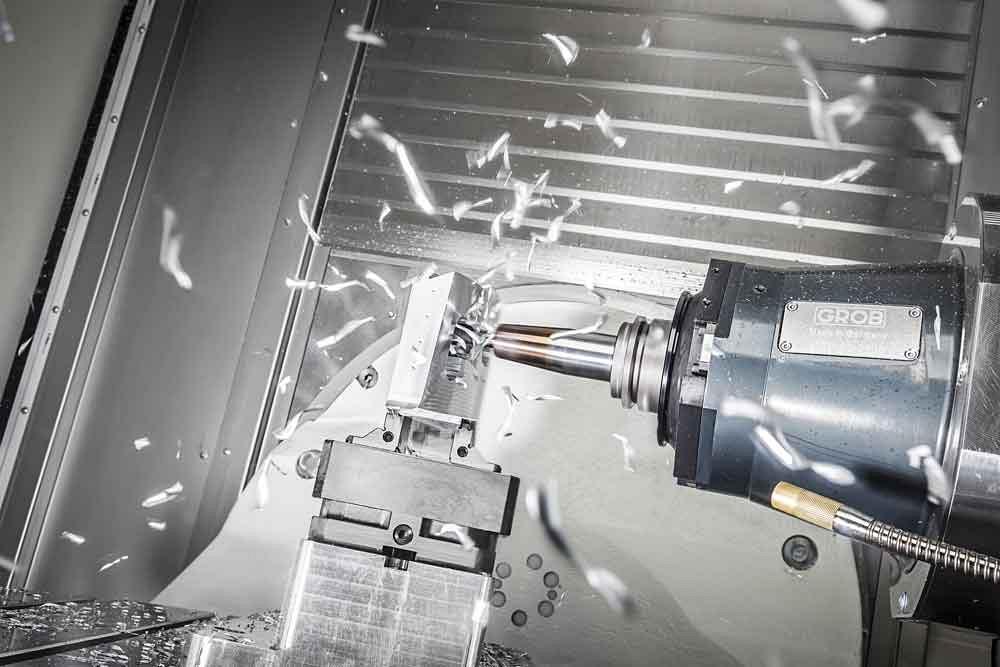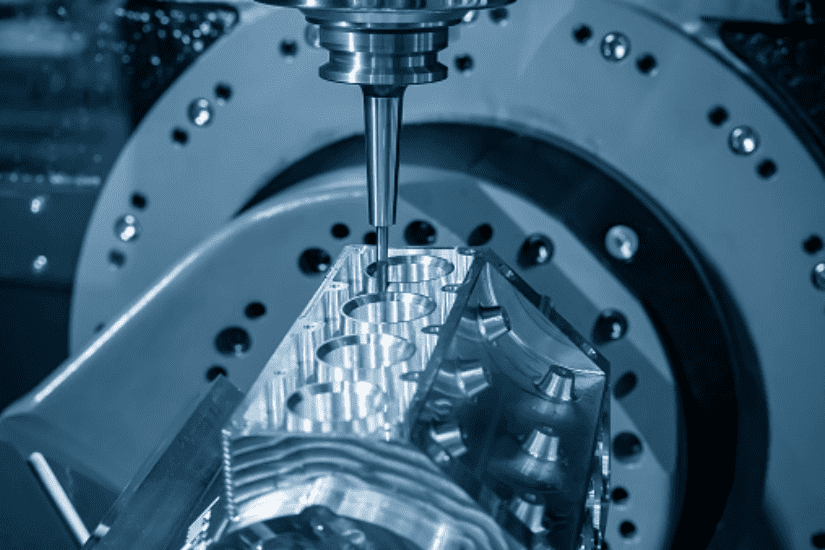To use 5-Axis CNC machining for improving part accuracy, understand the machinery basics, recognize key factors affecting precision, apply targeted techniques to enhance accuracy, and utilize advanced software for optimal precision.
Understanding 5-Axis CNC Machining
5-Axis CNC (Computer Numerical Control) machining is a pinnacle of advanced technologies in manufacturing; it provides exceptional accuracy with versatility. 3-axis vs. 5-axis Unlike conventional three linear axes (X, Y, and Z), which permit movements along only three different paths) configurations the five-axes machines have two additional rotational Axes: A & B…. Besides Diverse range of processing options for creating simple geometries to complex geometry with high accuracy due addition movement capability emerging in those extra accessible dimensions etc….
Flexibility and Precision
These additional A and B axes are also what enables 5-axis CNC machines to orient the cutting tool or part in ways fundamentally impossible with older models of machining centers. Skill flexibility allows the cutting tool to approach its ideal position with respect to a workpiece instantly, where it wears minimally and accuracy trumps all. As a result, this decreases the demand for secondary processing and manual finishing which in turn increases productivity speedily along with lower manufacturing costs.
Machining Complex Geometries
5-axis machines are great for rendering parts with complicated geometries and fine details. They play a critical part in aerospace, automotive and manufacturing of medical devices where components are frequently comprised complex contours that demand precision. A 5-axis machine can achieve the exact aerodynamic properties needed by a blade of turbine or in forming an organic shape for a prosthetic better than any other type.
Reduced Setup Time
Setup time in 5-axis machining One of the most important advantages is that it reduces setup times. Machining five sides of a part in one setup decreases the total production time, but it also increases output consistency. Benefit of Less setups:- Fewer Set-ups = fewer chances for errors and differentials; hence a more uniform batch is achieved. This is extremely useful in high-volume production settings where efficiency and consistency are critical.
Enhanced Tool Life
Optimal tool orientation as well ongoing part interaction allow a better surface finish, but also make your cutting tools last longer. Reduced Tool Breakage the maintaining of optimal condition for cutting in 5-axis CNC machines prevents tools from getting worn off and breaking. Utilization of tools in this manner, contributes to a more sustainable operation with reduced tooling costs and less frequent changes.
Software Integration
Modern 5-axis CNC machines are often tied to very powerful CAD/CAM software that can model shapes and generate tool paths with amazing precision. It enables precise preplanning and simulation of machining processes to correct mistakes before any cutting occurs. Tool path optimization – Improve tool paths with advanced algorithms, leading to better surface finish and / or shorter machining time.

Key Factors Affecting Accuracy
The high level of accuracy demanded in parts driven by critical specifications (aerospace, medical or automotive) makes achieving accurate 5-axis CNC machining a necessity. Many key factors affect 5-axis CNC machine accuracy, and this guide can help operators (and engineering department planners) understand how to improve their manufacturing processes.
Calibration and Servicing machine
One of the most critical components to achieve an accurate 5-Axis CNC machine is calibration. Calibration implies the adjustment of a machine to get its all axes in perfect alignment and working according some very exacting specifications dictated by software. It is important that the machine be properly maintained which includes monitoring and adjusting alignment, cleaning parts of any debris and replacing worn out components over time in order to keep it functioning with acceptable accuracy. E.g.; table spindle misalignment -> results in even bigger deviations as a end product and that is not good for precise (=exact) engineering.
Tool Quality and Condition
CNC Machining tools have a big impact on the accuracy and quality of your work. Tools of better quality last longer and will make cleaner cuts as well. Dull or chipped tooling often results in burrs, warping and oversized components. Tools are not something that should be ordered for change once in a blue moon, but instead regularly inspected and replaced to ensure they do not become an issue holding back quality. Tool Balancing is also important when unbalanced can cause the tools vibration that results in damaging of process precision.
Workpiece Setup
How to clamp and align the workpiece on the machine table will great affect machining accuracy. The process was so vulnerable to movement and instability, if things were not setup properly it could result in an inaccurate part while being machined. Methods such as vacuum fixtures, hydraulic or magnetic clamps and custom jigs all ensure piece stability and proper positioning over the course of machining. Accurate settings are crucial in particular for the machining of complex parts or at high speeds.
Thermal Stability
Temperature variations can affect the machine stability and cause inaccuracy of parts dimensions. Thermo-Comp CyclesThis will be less of an issue for shops limited to typical 5-axis work if their CNC has thermo-comp cycles, processes that adjust the machine’s operational parameters based on temp data. Although ensuring an enclosed environment can reduce the possibility of thermal drift. In order to keep the needed quality, it is required that operators monitor and control temperatures in their machining environment.
Control System Precision
Super-Precise, Super-Responsive CNC Control —The software necessary to control the actions of a machine in real time just stated. Examples of such a high-quality control system include more sophisticated motion mechanisms, essential for complex tool paths executed with pinpoint accuracy. Existing machines can also be made more accurate with firmware updates and software improvements.
Techniques To Improve Accuracy
To work out these challenges and enhance the accuracy in 5-axis CNC machining, it might be finished with a combination of advanced strategies at some points for careful planning and use of state-of-the-art technology. These strategies, when put into place, will enable operators to get much more performance out of their machining process and always produce parts that are kept well within the tolerances needed.
Adaptive Machining
Adaptive machining technology varies cutting conditions according to the feedback from a process of real-time monitoring in order to avoid these risks. This approach is characterized by the monitoring of sensors for tool wear, material anomalies and environmental influences. Based on this information, the system will dynamically change tool paths and adjust cutting speeds to offset any observed variances allowing for high precision machining across a work piece. In the case of tool wear being detected, raw material is automatically machined so cutting depth can be adjusted to allow a final part with correct measurements.
Tool Path Optimization
The choice of optimal tool paths is important, to create better machining precision. With these machining strategies built in, advanced CAD/CAM software can simulate them and help users choose the right strategy for their goals. The process software of HyperMill, Smart NC and Mastercam calculates the most efficient and close to optimum toolpaths for reducing number if times a tool can be dropped on target area where additional passes are required with minimal machining risk like deflection or chatter. This not only will enhance the surfacing finish but also guarantees the geometric accuracy of these complicated components.
High-Precision Tooling
More accurate 5-axis machining can be achieved by using high-precision, dedicated tooling created for intricate and sensitive procedures. It is preferred for tools to have sharper cutting edges, higher precision and materials can wear over time. Furthermore, the use of toolholders that feature low vibrations and high rigidity such as hydraulic or shrink-fit holders can dramatically increase cutting accuracy by keeping the tools in line and significantly reducing deflection.
Rigorous Quality Control
When it comes to machining accuracy, applying strict quality controls during the process decides everything. This includes the routine inspection and measurement of parts being produced using precision tools like CMMs (Coordinate Measuring Machines) and laser scanners. Since operators are able to quickly measure machined part dimensions against CAD models, they can recognize any deviation early in process and take corrective measures.
Vibration Damping and Tuned to Maximize Stability
It is very important to reduce vibrations in 5-axis CNC machining, as can be seen from the need of high precision. Motor : Putting vibration damping systems on the engine. to soak up and decrease process vibrations effects. It also increases the stability itself, a perfect foundation and installing your machine tools in an area free from vibrations (no CNC next to heavy machinery or traffic) can further improve working accuracy.

The Role Of Software In Precision
Software: The Critical Part of 5-axis CNC Machining Software has been the lifeblood to maintain and achieve high accuracy in using 5- axis basics. The accuracy, efficiency and quality of the machined parts are directly impacted by more advanced software capabilities. Using the advancements in CAD/CAM tech of The Lastest Time, manufacturers can improve their machining processes entirely.
CAD/CAM Software Integration
CAD/CAM integration is necessary to take complex designs and turn them into exact machining instructions. This software method provides the fine control over all parts of the machining technique which ranges from design to manufacture. Not all bits are designed for cutting depth, meaning every time it can extend the entire groove lower on this kit -compatibility with CAD/CAM software which construct complex toolpaths that instruct how an individual cut is to be performed having a 3D printer axes. This is incredibly valuable in 5-axis machining, without which the angles and tool path that applied to get an effective surface finish or needed dimensionality all come down accordingly.
Simulation and Visualization
CAD/CAM software will simulate the whole machining process before it starts milling for real, giving a virtual idea of how the machine is going to conduct operations. This simulation is critical in bringing to the forefront issues such as collision between tool and workpiece or machine components, which means that these can then be resolved before actual machining takes place. This predictive ability is a game changer because it greatly minimizes the danger of expensive errors and improves precision at large.
Toolpath Optimization
The main impact of optimization algorithms for toolpaths is to improve the machining accuracy. These algorithms are able to analyze the part geometry and make decisions on how best to move the cutting tool around in order enable accurate machining of parts. These calculations are based on the cutting tool geometry, material properties and desired finish to maximize the speed in which you cut AND FONT THE DEPTH And DIRECTION OF EACH CUT. Optimized toolpaths are going to save wear and tear on your tool, prevent cutting away excess materiel or air during the machining process,and get you that part as fast as possible.
Feedback and Live Updates
There are even more advanced machining software solutions, that include real-time feedback systems to adjust the toolpaths during the process of production. These can alert to parameters such as wear of the tool, forces applied or temperature and vibration using specific sensors. If the deviations from the expected values, are detected then software compensates for this by adjusting to machining parameters which maintain the precision part end production.
Access and DataManagement
The abilities to manage data effectively within the CNC software further help with precision in 5-axis machining. These include the ability for CAM programmers to quickly open and edit CAD models, toolpaths and machining parameters. The automotive engineering team used this tool to map 2200 different parts, and they created a design automation system that seamlessly integrated with quality control systems, automatically updated data across the factory floor but also ensured that even minute modifications in the manufacturing plan didn’t destabilize machining consistency.








